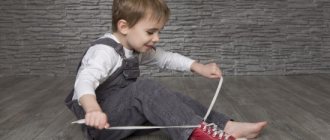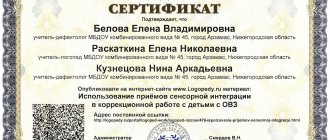Defectological representation of a student with intellectual disabilities
Defectological representation of the student
Full Name:
student
Date of Birth:
03/24/2008 (9 years, 9 months)
School №_3_grade 2 "a"
Emotional response in an examination situation:
makes contact with teachers easily, has a positive attitude towards the examination situation, praise creates a situation of success, orderly behavior, is not critical of the results of his own activities (does not notice his own mistakes, corrects them when pointed out).
Development of gross and fine motor skills:
the development of general motor skills is close to the age norm, the development of fine motor skills is low (he draws, colors carelessly, often goes beyond the outline of the drawing, the pressure is weak).
Learning ability:
Learning Ability:
able to work according to a model, instructions, independently
,
receptivity to help
: accepts the help of a teacher, depending on the type of activity, needs stimulating, organizing, guiding and teaching assistance.
The method of action shown partially transfers to similar tasks.
Features of the organization of activities, the formation of regulatory functions
Accepts the task, cognitive activity is not formed, cognitive interest in the task is maintained with stimulating help in the form of a positive emotional mood, difficulties in work do not cause negative emotions, and overcomes with explanation. Doesn't plan his activities
Work pace:
low, the decrease is associated with the characteristics of the emotional-volitional sphere.
Performance:
insufficient (does not follow the algorithm of tasks, gets tired quickly while working on tasks).
Not critical of the results of his own activities (does not notice his own mistakes, corrects them when pointed out).
General stock of ideas/knowledge:
Knowledge and ideas about oneself and family are below the age norm. He gives his first and last name, knows his age, but doesn’t know his date of birth. He does not give his home address. General ideas about the world around us do not meet age requirements (knows the seasons and their sequence, does not know the names of the months, names the days of the week with help. The concept of “yesterday” is not formed, “today, tomorrow” is understood. Knows the name of the country, but does not have the capital. Animals names, but does not differentiate between wild and domestic, names vegetables and fruits, but does not differentiate, pieces of furniture, vehicles in pictures, recognizes and names.
Formation of spatio-temporal representations:
Orientation skills in space and time are not sufficiently developed, he can determine the right-left hand, in space he cannot independently determine the right-left side, he is partially oriented on a sheet of paper. A graphic image of an object is copied by cells using. Collects cut-out pictures from 4 parts (vertical-horizontal). In the school premises he orients himself independently.
Peculiarities of perception
:
Visual perception is impaired: the perception of superimposed (3 out of 5), crossed out images is difficult, and does not recognize half-drawn images.
The main colors are distinguished, the difficulty is the difference in shades of colors.
Understanding instructions received by ear:
understands instructions after repeated repetition and explanation.
Features attention:
attention is unstable, distracted by external stimuli, incapable of long-term focus and concentration on work. Distribution difficulties, slow switchability.
Memory Features:
low productivity of memorization, indirect memorization (3 out of 6), upon repeated presentation 4 out of 6. The volume of auditory-verbal memorization is reduced (2 out of 10).
Level of development of mental operations:
Generalization and exclusion are carried out unevenly, according to essential features (only in mild cases). The fourth extra one highlights in the pictures, according to the main features, organizing assistance is needed at the stage of speech generalization of the highlighted features.
The classification was not carried out in full, he takes help, explains his choice with help. When carrying out subject classification, he correctly understands the instructions, is in a hurry, is distracted, organizational help is needed. He has not fully established logical connections between phenomena and objects (simple non-verbal analogies), it is necessary stimulating and guiding help from an adult.
I laid out a series of plot pictures and composed a story using leading questions.
Formation of study skills
Partially assimilates program material in academic subjects at a minimum level.
Mathematics:
Knows basic geometric figures. Mechanical counting within 15, counting backwards is not mastered, does not correlate the number and quantity of objects, does not establish the relationship “more” “less”. Names and writes numbers. Addition and subtraction within 5 are performed using visual material with teaching assistance.
- typical mistakes: inattentive.
Russian language:
- calligraphic writing skill: not sufficiently developed.
Features of speech development:
SNR of moderate severity.
General sound of speech:
the speaking voice is quiet, the pace of speech is slow. Speech is intelligible.
Lexicon:
The active vocabulary is represented by everyday topics.
Connected speech:
not formed enough. A story based on a plot picture is characterized by a violation of the coherence of the presentation; low information content; poverty of lexical and grammatical means of the language; difficulties in the linguistic implementation of the plan.
General characteristics of educational activities
: the actual educational motivation is reduced, the level of independent work is low, the plannedness of activities, self-control, and arbitrariness are disrupted.
Conclusion:
The general stock of ideas and knowledge is below the age norm. Receptive to help, needs stimulating, organizing, directing and teaching assistance, step-by-step adult control. Instructions perceived by ear are understood after repetition and explanation. Low productive memorization. Incapable of long-term concentration and concentration on work. Low level of mental operations.
Insufficient development of educational skills. Own educational motivation is reduced, low level of independent work, inability to exert volition, the regularity of activities, self-control and volition are impaired.
The pace of work is low, efficiency is insufficient.
Directions of correctional work:
- Development of arbitrariness of mental activity;
- Development of mnestic processes;
- Development of grapho-motor functions;
- Development of temporal representations;
- Development of mathematical concepts;
- Development of speech activity;
- Development of thinking.
- Monitoring in December, passing the CPMPK in order to determine the further educational route (clarification of the AOEP option)
Completion date September
Defectologist_______________________
Job responsibilities of a speech therapist teacher
Carries out work aimed at maximizing the correction of developmental deficiencies in students, pupils with developmental disorders, including those in special (correctional) educational institutions created for students, pupils with disabilities (for the deaf, hard of hearing and late-deafened, blind, visually impaired and late-blind children, children with severe speech impairments, musculoskeletal disorders, mental retardation, mentally retarded and other children with disabilities).
Conducts examinations of students and pupils, determines the structure and severity of their developmental disorders.
Completes groups for classes, taking into account the psychophysical state of students and pupils.
Conducts group and individual classes to correct developmental deficiencies and restore impaired functions.
Works closely with teachers, educators and other educational staff, attends classes and lessons.
Consults teaching staff and parents (persons replacing them) on the use of special methods and techniques to assist children with disabilities.
Maintains necessary documentation.
Promotes the formation of a general personal culture, socialization, informed choice and mastery of professional programs.
Implements educational programs.
Completes groups for classes, taking into account the psychophysical state of students and pupils.
Studies the individual characteristics, abilities, interests and inclinations of students and pupils in order to create conditions to ensure their development in accordance with the age norm, the growth of their cognitive motivation and the formation of educational independence, the formation of competencies, using a variety of forms, techniques, methods and means of teaching, modern educational technologies, including information and digital educational resources, ensuring the level of training of students and pupils that meets the requirements of the federal state educational standard, federal state requirements.
Conducts training sessions based on achievements in the field of methodological, pedagogical and psychological sciences, developmental psychology and school hygiene, as well as modern information technologies.
Respects the rights and freedoms of students and pupils.
Ensures the protection of life and health of students and pupils during the educational process.
Participates in the work of pedagogical, methodological councils, other forms of methodological work, in the work of holding parent meetings, recreational, educational and other events provided for by the educational program, in organizing and conducting methodological and advisory assistance to parents (persons replacing them).
Complies with labor protection and fire safety regulations.
Requirements for the qualifications of a speech therapist teacher:
Higher professional education in the field of defectology without any work experience requirements.
Source: Unified Qualification Directory of Positions of Managers, Specialists and Employees, section “Qualification Characteristics of Positions of Education Workers.”
- Regulations on the organization of work of a speech therapist teacher in a kindergarten without special groups (2000)
- Documentation of the speech therapist teacher and its maintenance
- Qualification test (exam) questions for the position of Speech Pathologist Teacher
- Speech therapist annual work plan
- Characteristics of the teacher for the child (for examination at the PHC Consultation)
( 4 liked, average score: 5.00 out of 5)
Loading...
The speech therapist should know:
- priority directions for the development of the educational system of the Russian Federation;
- laws and other regulatory legal acts regulating educational, physical education and sports activities;
- Convention on the Rights of the Child;
- developmental and special pedagogy and psychology;
- anatomical, physiological and clinical foundations of defectology;
- methods and techniques for preventing and correcting deviations in the development of students and pupils;
- normative and methodological documents on issues of professional and practical activity;
- program and methodological literature on working with students and pupils with developmental disabilities;
- the latest achievements of defectological and pedagogical sciences;
- labor protection and fire safety regulations;
- theory and methods of managing educational systems;
- modern pedagogical technologies for productive, differentiated, developmental education, implementation of a competency-based approach; methods of persuasion, argumentation of one’s position, establishing contacts with students, pupils of different ages, their parents (persons replacing them), work colleagues; technologies for diagnosing the causes of conflict situations, their prevention and resolution;
- fundamentals of ecology, economics, sociology; labor legislation;
- basics of working with text editors, spreadsheets, email and browsers, multimedia equipment;
- internal labor regulations of an educational institution; labor protection and fire safety rules.




